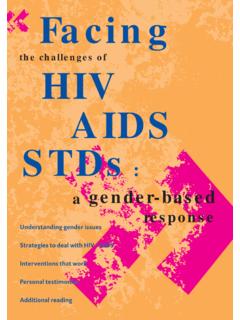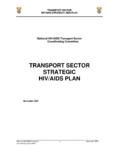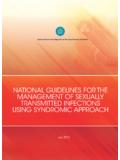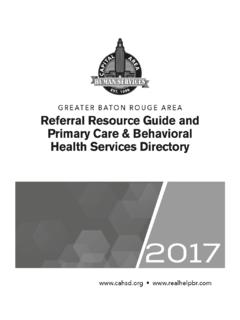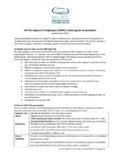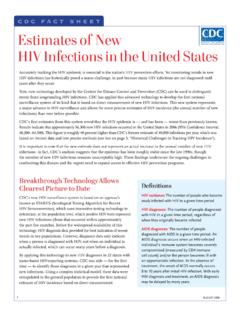Transcription of Factors influencing Sexual Risk Behaviors among Senior ...
1 International Journal of Scientific and Research Publications, Volume 4, Issue 8, August 2014 1 ISSN 2250-3153 Factors influencing Sexual Risk Behaviors among Senior Secondary School Students (Youths) Dekeke GD & Prof. Sandy PT Master of Public Health in the subject Health Studies at the University of South Africa Abstract- This quantitative descriptive cross sectional study explored Factors influencing Sexual risk behaviours among youths in Senior secondary schools in Ethiopia. Data were collected using structured questionnaires. Religious attachment, living with friends, living alone, parental control, level of parental education, peer pressure and number of friends who had experienced sex were some of the Factors noted to influence youths to engage in Sexual risk behaviours. The findings of this study have implications for both practice and policy development.
2 They will enable healthcare workers to identify youths at risk of engaging in Sexual risk behaviours and subsequently motivate them using health promotion strategies to engage in safe Sexual practices. Adopting such an approach will prevent or at least minimise risk of youths being infected with sexually transmitted diseases, such as HIV/AIDS. Index Terms- Senior secondary schools, Sexual risk behaviours, sexually transmitted diseases I. INTRODUCTION, BACKGROUND, STATEMENT OF PROBLEM INTRODUCTION exually active youths are at risk of contracting sexually transmitted diseases, including Human Immune Deficiency Virus (HIV) infection. There are psychological and behavioural Factors associated with the risk of sexually transmitted diseases like HIV/AIDS (Gebregiorgis 2000:15). The same study reported that understanding Sexual risk behaviours is one of the most important issues in preventing the spread of HIV and AIDS.
3 Doing so will result in the design and implementation of health education programmes with the view of preventing these infections or at least minimise their occurrence. Therefore exploring the Factors that may influence Sexual risk behaviours among youths in high schools was the point of interest for the researcher in conducting this study. Taking this into account, the researcher designed a comparative cross sectional study that was carried out in two high schools in Ethiopia to examine Sexual risk behaviours, including condom use, assertiveness, frequency of Sexual intercourse and number of Sexual partner among secondary school students. BACKGROUND TO RESEARCH PROBLEM At the beginning of the new millennium, approximately billion people, which is more than a quarter of the world's population, were between the ages of 10 and 24, and 86 percent of these youths were living in less developed countries (Solomon 2004:1).
4 It is reiterated in a number of publications that these youths are tomorrow's parents (Solomon 2004:1). While some authors appear to support this view, they also consider the term youth as a period during which people explore and discover a range of life events or behaviours, such as early onset of Sexual intercourse (Kauffman, Orbe, Johnson and Cooke-Jackson 2013:783). It must be mentioned that the price for early onset of Sexual activity is high, as each year over one million teenagers become pregnant and over four million are diagnosed with a sexually transmitted disease (STD) (Kauffman et al. 2013:1-10). This is certainly a concern, and thus, this developmental stage deserves more attention and discussion. Youth is the transition between childhood and adulthood. The increasing independence of youths brings about new challenges and risks resulting in marked differences in patterns of morbidity and mortality compared with younger children (Animaw 2009:10).
5 Youths are more likely to engage in risky behaviours, such as substance use and unsafe Sexual practices. Despite this, youths have not traditionally been considered a health priority since they have lower morbidity and mortality rates than older and younger age groups (Mensch, Clark and Anh 2003:249-262.). According to Bayley (2003:832), youths are twice as much likely to die from pregnancy-related health complications, such as excessive bleeding and uterine infection like myometritis. It is critical to mention that pregnancy among youths could be a function of Sexual risk behaviours, such as unprotected sex and early Sexual initiation. Taking this into account, it is important to explore these issues further. A recent study by Adamu, Mulatu and Si (2003:5) explored Factors of Sexual initiation, subsequent risk behaviours, and condom use among 1,102 youth students in secondary schools in some parts of Ethiopia.
6 In his study, two-thirds of the Sexual initiations were unprotected and some occurred with casual or commercial sex partners ( ). It is asserted in the same study that multi-partnered sex ( ) and sex with casual ( ) or commercial ( ) partners were the most commonly reported lifetime risk behaviours. of the youths claimed to never use condoms. Even though this was the case, half of them indicated to have used them regularly and claimed to feel protected by condom use from sexually transmitted infection. The study clearly indicated that geographical locations of subjects was related to such usage of condom and expressed feelings of safety. Socio-demographic characteristics, particularly gender, location, and age, are significantly correlated with Sexual and preventive behaviours (Gebregiorgis 2000:7).
7 It is therefore important to explore these Factors in research studies, as engaging in Sexual risk behaviours could result in negative consequences. For example, Sexual risk behaviours could lead to unwanted pregnancy, which in turn has negative implications. S International Journal of Scientific and Research Publications, Volume 4, Issue 8, August 2014 2 ISSN 2250-3153 Unwanted pregnancy have been noted in the literature to contribute to youths` dropping out of school and development of illnesses and even death associated with abortion and STDs, including HIV/AIDS (Bayley 2003:832-843). Acknowledging these consequences, this is a concern for all healthcare professionals. Despite this, Factors influencing Sexual risk behaviours are poorly understood in Ethiopia, as there are limited studies of these in this state (Bayley 2003:832-843).
8 In fact, there are no studies in Amhara region, specifically in Enemay District. It is therefore critical to explore Factors that may influence Sexual risk behaviours in this area of Ethiopia. STATEMENT OF THE RESEARCH PROBLEM High exposure of youths to STIs associated with unsafe Sexual practices, such as unprotected sex is an important and sensitive issue in sexually active age groups (Animaw 2009:5). The consequences of young people s Sexual behaviour when not using contraception have become a global issue mainly because it is associated with pregnancy and STIs (Turnbull 2010:78). The incidence and prevalence of HIV among youths are generally higher relative to cases in adults (Turnbull 2010:78). This is probably because of their Sexual activeness and tendency to frequently engage in unsafe Sexual practices, such as unprotected sex (Guzman and Bosch 2007: 123).
9 This is also noted among youths in Ethiopia and hence, the high prevalence of HIV/ AIDS cases in this population. Despite this, very limited research has been done in this regard in Ethiopia and to date there are no published empirical studies on Factors relating to Sexual risk behaviours in the Enemay District, East Gojam Zone of Ethiopia (Animaw 2009:5). Hence, this study explored Factors that may influence youths to engage in unsafe Sexual behaviours with the aim of providing appropriate recommendations for reducing or preventing unsafe Sexual practices among youths in Senior secondary schools. AIM OF THE STUDY Research purpose The purpose of the project was to explore Factors influencing Sexual risk behaviours among secondary school students (youths) in Enemay District and East Gojam Zone in Ethiopia. The researcher also intended to use the findings of the study to offer recommendations to service providers that will help prevent or at least reduce unsafe Sexual practices among secondary school students (youths).
10 Specific research objectives 1. To identify Factors that may influence Sexual risk behaviour. 2. To describe student s perceptions about Factors influencing Sexual risk behaviour 3. To develop recommendations for interventions to reduce Sexual risky behaviours. SIGNIFICANCE OF THE STUDY The issue of Sexual risky behaviours among youths in Ethiopia is very important for the prevention of problems relating to unwanted pregnancy and Sexually Transmitted Infections (STIs), including HIV/AIDS. Thus, it is expected that this study would contribute to the development and implementation of appropriate health promotion programmes to reduce both the incidence and prevalence of Sexual risk behaviours and their associated problems, including HIV/AIDS. Ethiopia is a growing nation with a high youth population.










